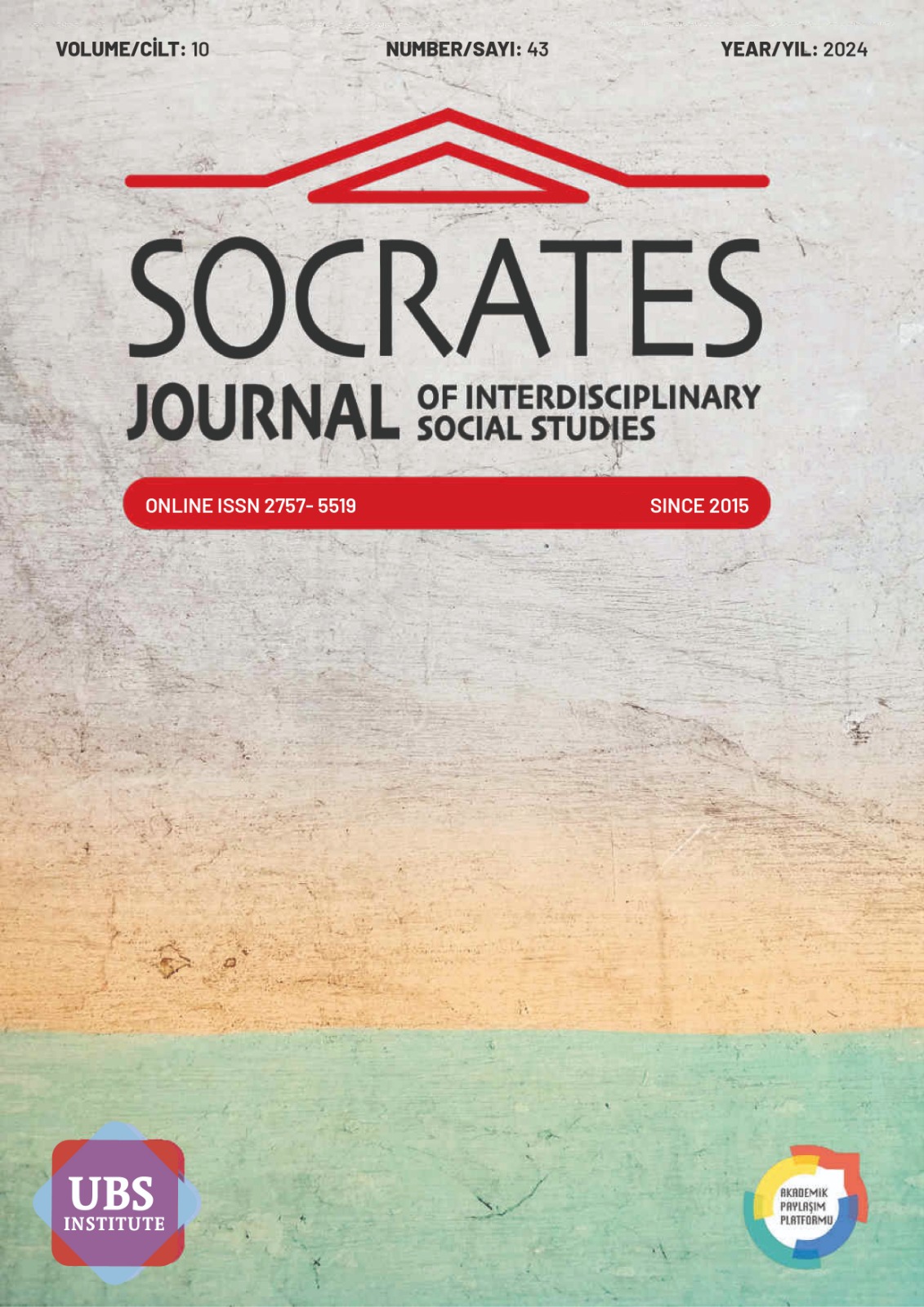SLOW CITY MOVEMENT IN THE CONTEXT OF SPEED AND SLOW CONCEPTS: THE CASE OF SEFERIHISAR
SLOW CITY MOVEMENT IN THE CONTEXT OF SPEED AND SLOW CONCEPTS: THE CASE OF SEFERIHISAR
DOI:
https://doi.org/10.5281/zenodo.12790895Keywords:
Concepts of Speed and Slow, Slow City, SeferhisarAbstract
With the Industrial Revolution, the change affecting many fields has also differentiated the production process. As seen before industrialization, production has become not only self-sufficient but also consuming. Thus, the speed of production, the increase in the amount of products to be produced and the presentation of these products to the consumption area were put into practice. This increase affects more raw materials, machine power, goods produced, and transportation. In this way, large companies and factories were rapidly formed to employ more consumers and more people. As a result, the importance of speed is also evident in the replacement of manpower by machines. With the impact of the Industrial Revolution, the production process has changed and thus the speed of production has also changed. Therefore, depending on this production, work, transportation and consumption have also accelerated. With this acceleration process, modernization and globalization have entered into a mutual interaction. Today, with the development of technology, it is seen that the element of speed has gained an important position in our lives. When the concept of speed is defined in general terms, it is considered as the speed of realization of a situation, the time it takes for something to occur and change. The existence of time gained when an action is performed reveals the social importance of speed. Therefore, to some extent, speed is considered as a concept related to time. The speed of a certain movement expresses its temporal brevity. The main context here is the evaluation of time as the gain of speed. Within the framework of these thematic elements, the example of Seferhisar will be analyzed uniquely in this study.
References
Ak, D. ve Bıçkı, D. (2016). Yavaş kent hareketinin kentsel yaşam kalitesi bağlamında değerlendirilmesi. Uluslararası Sosyal Araştırmalar Dergisi, 9(46), 615-632.
Balcılar, M., Ekwueme, D. C. ve Çiftçi, H. (2023). Assessing the effects of natural resource extraction on carbon emissions and energy consumption in Sub-Saharan Africa: a STIRPAT model approach. Sustainability, 15(12), 9676.
Büyük Larousse Sözlük ve Ansiklopedisi. (1992). 7- Cilt. Milliyet Yayınları.
Can, Z. G. ve Çiftçi, H. (2023). International remittances and poverty: blessing or curse? Ekonomicky Casopis, 70(6), 544-561.
Cittaslow Türkiye (2023).http://cittaslowturkiye.org/uyelik-sureci-ve-kriterler/, 06.05.2024.
Cittaslow. (2023). Cittaslow’un Türkiye’de oluşumu. https://Cittaslowturkiye.Org/Pdf, 02.04.2024.
Cittaslow’un genel organizasyonu ve yapısı. (2023). Erişim adresi: Https://Www.Cittaslow.Org/Content/Organization.Html, 06.05.2024.
Çakıcı, A. C. ve Yenipınar, U. ve Benli, S. (2014). Yavaş şehir hareketi: Seferihisar halkının tutum ve algıları ile yaşam doyumları. Seyahat ve Otel İşletmeciliği Dergisi, 11(3), 26-41.
Çiftçi, H. (2022). Göç yoksulluk ve ekonomik özgürlükler. Akademisyen Kitabevi.
Çiftçi, H., Bilgin, C., Kaynar Bilgin, H. (2023). Effects of demographic change on economic growth: A panel ARDL approach for selected OECD countries. Prague University of Economics and Business, 32(6), 589-607. Doi: 10.18267/j.pep.846
Daş, E. (2007). Sığacık’ta Türk Mimarisi (Seferihisar-İzmir). Sanat Tarihi Dergisi, 16(1), 25-48.
Doğutürk, G. (2010). Mimari ve yaşam kalitesi bağlamında yavaş şehir hareketi ve Seferihisar örneği. Yayımlanmamış yüksek lisans tezi, Mimar Sinan Güzel Sanatlar Üniversitesi, İstanbul.
Erten, S. (2009). Cittaslow/Yavaş Şehir Seferihisar. Arredamento Mimarlık Dergisi, 9, 106-109.
Honore, C. (2008). Yavaş. İstanbul: Alfa Yayıncılık.
Kabaca, D. (2019). Endüstri 4.0 devrimi ve uygulamaları ile etkilerinin incelenmesi. Yayımlanmamış yüksek lisans tezi, Yıldız Teknik Üniversitesi, İstanbul.
Kabaklarlı, E. (2016). Endüstri 4.0 ve dijital ekonomi-dünya ve türkiye için fırsatlar, etkiler ve tehditler. İstanbul: Nobel Akademik Yayıncılık.
Kesgin, A. (2021). Industrial Education: A Philosophical Evaluation of the Background of the Evolving Situation. Entelekya Logico-Metaphysical Review, 5(2), 87-109.
Keskin, E.B. (2015). Yavaş Şehir. İstanbul: Uludağ Yayınları.
Kongar, E. (1993). Toplumsal değime kuramları ve Türkiye gerçeği. İstanbul: Remzi Kitabevi.
Lipson, L. (1993). Siyasal ve sosyal teori, demokrasinin felsefesi,(Çev. M. Erdoğen). Siyasal Kitapevi.
Mayer, H., & Knox, P. L. (2006). Slow cities: Sustainable places in a fast world. Journal of urban affairs, 28(4), 321-334.
Olgun, A. (2016). Yavaş şehir (Cittaslow): Seferihisar örneğiyle ekonomik ve mali yapı
Slow city (Cittaslow): Economic and financial structure with Seferihisar example. Yayımlanmamış yüksek lisans tezi, Karadeniz Teknik Üniversitesi, Trabzon.
Olgun, A. ve Tunçer, M. (2017). Seferihisar’ın Ekonomik ve mali yapısı üzerinden sakin şehir uygulamalarına ilişkin bir inceleme. Uluslararası Ekonomi ve Yenilik Dergisi, 3(1), 47-72.
Öncü, F. (2021). Somut olmayan kültürel mirasın sürdürülebilirlik problemleri. Art-e Sanat Dergisi, 14(28), 902-923.
Özkan, H. C. (2011). Bir sürdürülebilir kent modeli: Yavaş şehir hareketi. Yayımlanmamış yüksek lisans tezi, Yıldız Teknik Üniversitesi, İstanbul
Özmen, Ş., Birsen, Ö., Birsen, H. ve Çıtak, Ş. Ö. (2017). Salyongozun izinde Türkiye'nin sakin şehirleri. Ankara: Anı Yayıncılık.
Özsaraç, A. T. (2019). Hız ve yavaş kavramları bağlamında yavaş şehir hareketi. Yayımlanmamış yüksek lisans tezi, Kütahya Dumlupınar Üniversitesi, Kütahya.
Seferihisar Belediyesi, Cittaslow, www.seferihisar.bel.tr, 06.05.2024.
Şahinkaya, S. (2010). Bir yerel kalkınma modeli: Cittaslow ve Seferihisar üzerine değerlendirmeler.www.bagimsizsosyalbilimciler.org/Yazilar_Uye/SahinTem10.pdf, 24.04.2024.
Talas, M. ve Bildirici, S. S. (Eds.). (2008). Farklı yönleriyle küreselleşme. İstanbul: Doğu Kütüphanesi.
Tekeli, İ. (1982). Kentleşme yazıları. Ankara: Turhan Kitabevi.
Ünal, Ç. (2016). Turizm coğrafyasında yeni bir kavram ‘’Yavaş Şehirler’’. Doğu Coğrafya Dergisi, 21(36), 13-28.
Yalçın, E. (2019). Küresel kente alternatif olarak sakin şehir: Türkiye sakin şehirleri üzerinden değerlendirme. Sosyal Ekonomik Araştırmalar Dergisi, 19(38), 202-230.
Yurtseven, R., Kaya, O. ve Harman, S. (2010). Yavaş hareketi. Ankara: Detay Yayıncılık.
Downloads
Published
How to Cite
Issue
Section
License
Copyright (c) 2024 Socrates Journal of Interdisciplinary Social Studies

This work is licensed under a Creative Commons Attribution 4.0 International License.


